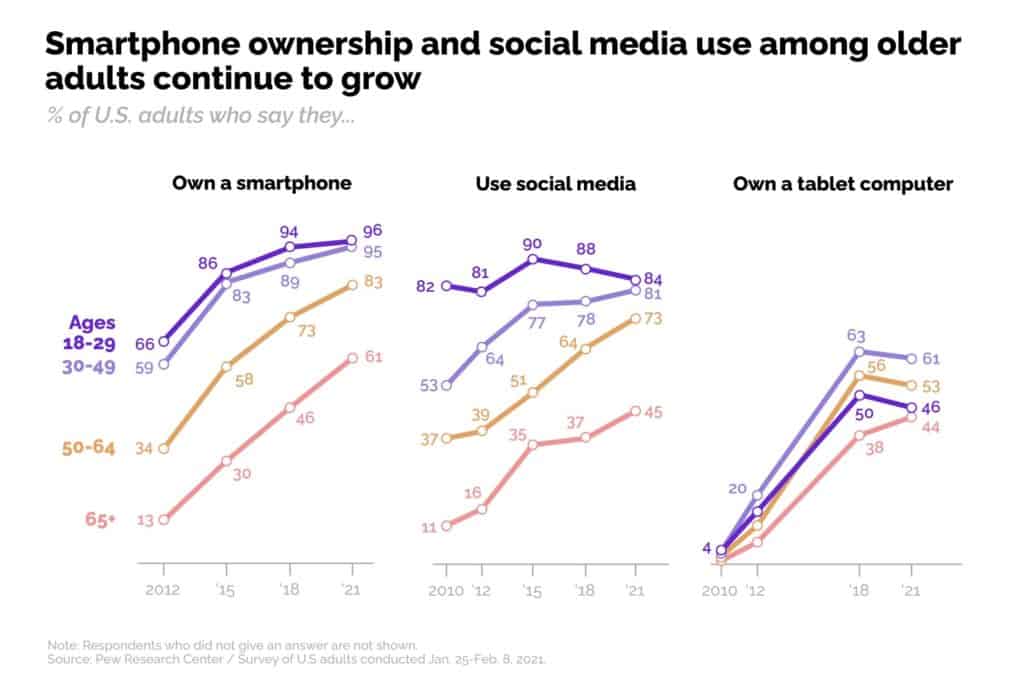Today, the marketing world is fixated on attracting Millennials and Gen Zs through the power of social media—we see you, TikTok and Instagram. There is no shortage of resources for Gen Z marketing and the most trendy, eye-catching ways to do it. But what marketers often overlook is that they’re missing out on some prime target audience real estate: Baby Boomers!
Gone are the days of flipping through a phone book, actually talking to a sales representative, and attending tradeshows and live events to learn about new products and services in the industry. Now, the world is a fast-paced digital landscape, and B2B companies shouldn’t throw the Baby Boomers out with the bath water in favor of the up-and-comers. The long-standing stereotypes surrounding senior consumers—including being out of touch or technophobes—are largely untrue. But their buyer behavior is different than that of their younger counterparts, and the way they use social media—including which platforms and what they like to engage with, also varies.
Marketing strategies start to lose focus and go lax once you look past Millennials. However, as the most financially secure generation, Baby Boomers hold 70% of the disposable income in the United States, spending over $548 billion a year!
Related reading: Marketing to Millennials – 10 Things Every Company Must Know
The problem is that businesses don’t fully understand the differences between certain consumer segments, especially when it comes to generational marketing. The key to generational marketing is understanding where customers find your brand and what type of language and messaging they respond to—it’s much more than using internet slang or making trendy references. While every generation has opportunities and challenges, you must remember that you’re marketing to a human being, not a concept. It’s essential to be familiar with who your audience is and try to meet them where they are.
So put your glasses on (because you’ll actually want to see this) and lean in as we explain how you can successfully market to the Baby Boomer generation.
What is a baby boomer?
Before businesses can market to anyone, they must know who they’re dealing with (or figure out their B2B buyer persona).
Baby Boomers consist of the population born after World War II between 1946 and 1964, making them 58 to 76 years old as of 2022. Dubbed the “Me Decade” by writer Tom Wolfe, Baby Boomers experienced significant political, cultural, and economic changes during the 60s and 70s—Woodstock, the Civil Rights Movement, the moon landing, Women’s Liberation, and the Rise of TV, to name a few. These events undoubtedly influenced who they are and how they make their purchasing decisions.
Boomers have seen a lot during their lifetimes and still firmly believe in the American Dream and brand loyalty. At around 73 million members strong, their self-assuredness, discipline, and work ethic have prepared them to see even more global advancements in the future. With more free time, disposable income, and high-ranking positions with decision-making power, every business should implement strategies that resonate with this demographic.
Fortunately, we can help you learn to speak their language.
Related Reading: What Tech Companies Need to Know About Marketing to Boomers
Baby Boomer Marketing 101
Most of the Baby Boomer generation didn’t grow up with the type of technology we consider commonplace, but they have adapted rapidly. According to Pew Research, 83% of people ages 50-64 own a smartphone, and 96% in that same age range report regularly using the internet, with 73% saying they use social media. At the later end of the Baby Boomer generation, the 65+ population reports that 75% use the internet, 61% own a smartphone, and 45% use social media—and those numbers are consistently rising.

This generation of transformation and digitalization has a different approach to purchasing products than their millennial counterparts. They are more hesitant to buy things on a whim because they see purchases as financial commitments.
They are more likely to read the fine print and to want all of the nitty-gritty details up front, yet they care very much about relationships—after all, their generation used to make buying decisions primarily based on discussions with salespeople and in-person events and buying experiences.
Here are five marketing tactics to effectively establish a connection with this resilient, adaptable, and classic generation.
5 Tips When Marketing to Boomers
1. Remember that age is just a number.
Super obvious tip: No one likes being called old.
But in our highly youth-focused culture, older generations are often disregarded or underestimated. Don’t fall for this trap.
Baby Boomers don’t see their age as a constraint on their ability to go after what they want—and you shouldn’t either. Entering the highest ranks in their respective companies and planning for their post-career lives—Baby Boomers are poised and ready to make important decisions and set the course for the path forward. As marketers, we should aim to empower these buyers to achieve their goals by showcasing the benefits our products or services add to their journey.
So be cautious of condescending language around age, or try to avoid mentioning it altogether.
2. Choose simplicity over stylized copy.
Like we said, Baby Boomers are more up-to-date than some might think, but that doesn’t mean that the same communication styles resonate with them. While they likely know basic text acronyms (lol, brb, etc.), and commonplace slang, they don’t want to be treated like your bestie or a baddie (even if they are). Using slang can create miscommunication and result in a lack of clarity. It can also make your business appear immature and inauthentic, alienating older prospects. The worst thing you can do for your brand is to spend time and money to reach an audience that doesn’t understand what you’re trying to convey.
Instead, keep your copy simple and straightforward. Use strong visual structures, like bulleted lists and tables, that enable your Baby Boomer buyers to quickly get the information they’re looking for without any linguistic fluff. Now, we aren’t saying that you should write bland and robotic B2B content—far from it. We’re simply suggesting you let the facts drive how you present the copy, focusing on clarity and conciseness over loquaciousness for the sake of schtick.
3. Meet them where they are (i.e., Facebook).
Baby Boomers use Facebook far more than any other social media to keep in touch with friends, family, and loved ones and to stay informed. While they may not be as prominent as the younger generations, their presence is growing rapidly, nearly doubling from 2012 to 2019. As a result, marketers have significant potential to meet them where they socialize and garner more interactions with their brands.
While Facebook advertising is a no-brainer for your B2B marketing strategy since it is a hotspot for activity, Boomers also have a strong presence on LinkedIn. You can even budget for Google paid search or add email marketing to your arsenal as data shows Boomers spend more time answering emails than younger generations. According to the Pew Research Center, there has been an uptick in YouTube usage from 2019 to 2021 among ages 50 to 64 (from 70% to 83%) and those 65 and older (from 38% to 49%). The addition of 13% and 11%, respectively, indicates how all generations are gravitating toward video content.
Again, understanding where your audience is and what makes the most sense for your brand will help determine where you should put your B2B paid advertising efforts.
4. Make your strategy accessible.
Boomers are active internet users, but they might not have as much patience with confusing or hard-to-use websites. You need to create content that’s easy to access and engage with. This practice of digital accessibility has become a core principle of user experience design and is especially important for aging populations.
Like younger generations, Baby Boomers prefer shopping online and are adept at researching and comparing products online as well. However, they’ll move on if they cannot access the content they need without struggling, like any potential buyer. To ensure that you can keep their attention, think about the different components that can increase accessibility, including:
- Font Size: We recommend not using fonts smaller than 12 pt to ensure clear readability. Although users can adjust font size directly on their devices, brands targeting the boomer population should be proactive to ensure users can easily read website content.
- Contrast: Dark typography on light backgrounds (or vice versa) puts less strain on the eyes.
- Button Size: Using proper button sizes, especially for mobile devices, helps with overall website accessibility.
- Multimedia Elements: Videos, images, and infographics are effective tactics for persuading readers to take further action, such as purchasing from your company. But too many visual components can cause information overload and distract from valuable information. Boomers aren’t looking for fast-paced, gif-heavy content. They want informative, straightforward content that doesn’t confuse or compete with other content components.
Related reading: 9 B2B Web Design Trends for 2022
5. Provide useful information.
We may sound like a broken record, but quality information is key for baby boomers. They react positively to information that proves your product is worth their money, and they respond to the facts—give them the information they need to feel equipped to make the best decision possible. As a result, showcasing clear benefits can help this demographic through the decision-making process.
There’s no way around the fact that the Baby Boomer generation is aging. Soon, Gen X, and eventually Millennials will be the boomers of our time, and before you know it, Gen Z will be graying too. The point is that marketers must consistently adapt their strategies to match the preferences of each generation.
Only focusing on what has up-and-coming business potential neglects the audience that is already a lucrative source of business. Instead, honing in on what makes each generation tick and then delivering relevant product messaging through the channels most likely to reach them will help you hit your goals.
Being able to pivot in a dynamic market will make your brand more desirable to every consumer, regardless of generation. Need a little help identifying your target generation? Let us help.







